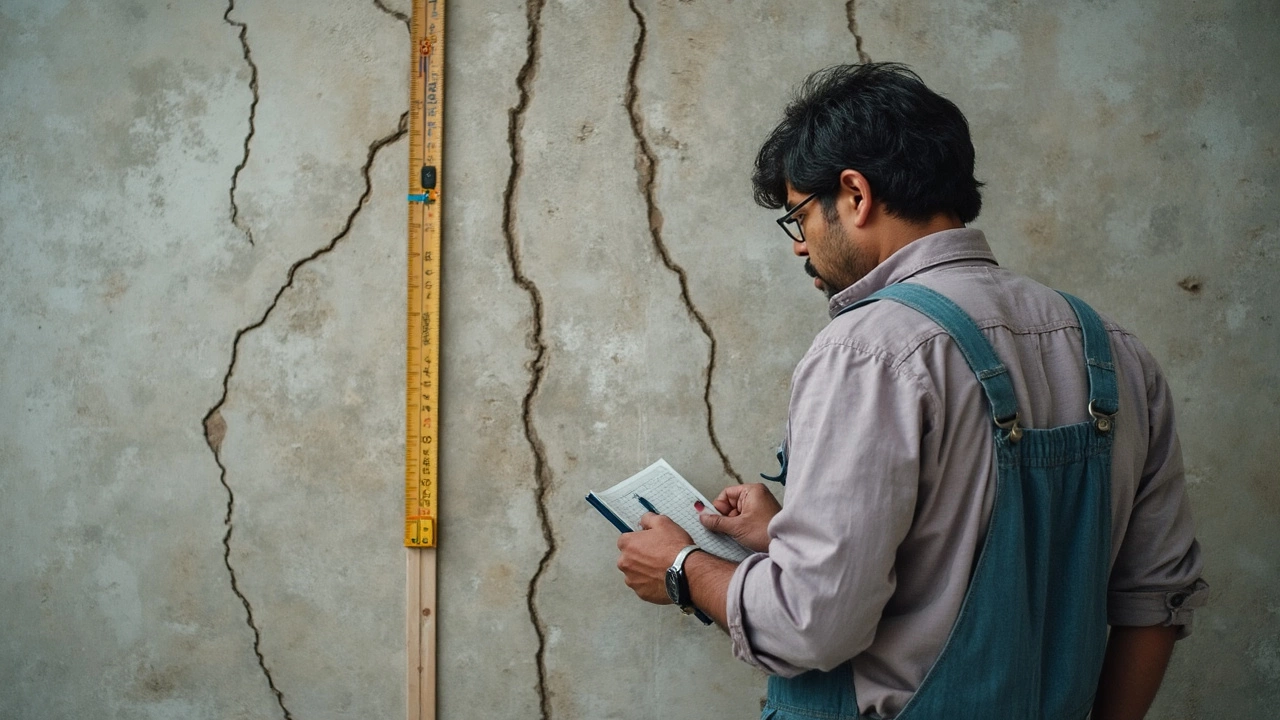See a crack running along your foundation? You're definitely not the only one. Homeowners spot these all the time—and most wonder if it's harmless or a giant red flag.
Here's the thing: not every crack means trouble. Foundations move a little over time, especially in places with clay soil or if there's been a dry spell. Tiny cracks—what pros call 'hairline cracks,' usually less than 1/16 of an inch wide—aren't usually a problem. They're even pretty normal after a new house settles in for the first few years.
But there’s a real difference between a barely-there line and a crack you can slide a coin into. Knowing where to draw that line can save you a ton of money and worry. We'll break down what sizes matter, what to watch out for, and which cracks you really shouldn't ignore.
- Why Do Foundation Cracks Happen?
- Measuring Up: Crack Size and What It Means
- When Is a Crack a Serious Problem?
- Tips for Monitoring and Fixing Cracks
- When to Call a Professional
Why Do Foundation Cracks Happen?
It's wild how many things can make a foundation crack. Most folks blame bad builders, but that's only part of the story. The real problem usually starts with water and soil—two things your house is always up against, no matter where you live.
The most common reasons for foundation crack size and issues are:
- Shrinking or swelling soil – Clay soil is a headache because it expands like a sponge when wet and shrinks when it's dry. This push-pull actually bends concrete over time. Sandy soils move less but don’t hold water well, which can also cause shifting.
- Poor drainage – Rainwater that doesn't drain away piles up next to your house. This softens the soil and shoves against the foundation, sometimes cracking it.
- Tree roots – Big tree roots close to the house suck water out of the soil, drying it up and causing the ground to shrink away from your foundation. That gap can let your walls settle differently over time.
- Bad concrete mix – If the original builders didn't use enough cement or water, that concrete might crack early on, with hairline cracks showing up in as little as the first year.
- Natural settling – New homes almost always settle a bit. It's normal to see small, thin cracks show up as everything adjusts in the first few seasons.
Ever wonder how common these problems are? Here’s a quick look at what professionals see most:
| Cause | Estimated Share of Foundation Cracks |
|---|---|
| Soil Changes (Shrink-Swell) | ~60% |
| Poor Water Drainage | ~25% |
| Tree Roots | ~10% |
| Construction Defects | ~5% |
Most foundation repair pros agree that the ground your house sits on is the real culprit most of the time. Knowing that makes it easier to spot trouble early and figure out which cracks actually matter.
Measuring Up: Crack Size and What It Means
Grab a tape measure, painter’s ruler, or even a credit card for this one—most folks don’t realize measuring a foundation crack size is the best way to figure out if you should worry or not. The size really does matter, and builders and inspectors usually agree on what's “acceptable.”
If a crack is less than 1/16 inch wide (about as thick as a dime), it’s called a hairline crack. These are super common, usually from minor settling or a normal shrinkage as concrete cures. Most of the time, these don’t affect the strength of your home’s foundation at all.
But once a crack hits 1/8 inch (as thick as two stacked credit cards), you need to pay more attention. Anything bigger than 1/4 inch becomes a bigger concern, especially if it keeps growing. Building codes and most contractors say that cracks wider than 1/4 inch could mean real movement—this is when you want to start thinking about a professional foundation repair assessment.
Here's a quick side-by-side for reference:
| Crack Width | What It Means | Action |
|---|---|---|
| <1/16 inch | Hairline crack, usually harmless | Mark and monitor |
| 1/16–1/8 inch | Still minor, but watch if it grows | Check periodically |
| 1/8–1/4 inch | Could mean movement, watch for other signs | Consult a pro if it expands |
| >1/4 inch | Major movement, structural risk | Get a foundation specialist ASAP |
Also pay attention to the length and direction—horizontal or stair-step cracks, especially if they’re wide, can signal pressure or shifting soil. While vertical cracks are often from settling, horizontal ones usually mean more serious problems with your foundation.
Keep in mind, not all cracks are created equal. Sometimes a wide but old crack isn’t getting worse, while a thin one that keeps growing each month is the bigger issue. That’s why marking cracks with a pencil and dating them can help keep track of any changes.

When Is a Crack a Serious Problem?
Cracks in your foundation don’t all mean the same thing. Some are just part of a home’s normal “settling in” phase, but others are a heads-up that something isn’t right. The key to knowing the difference comes down to crack width, shape, and how fast it's changing. Here’s what to look out for:
- If a crack is wider than 1/4 inch (about the width of a pencil), it’s time to pay attention. These aren’t the usual harmless hairlines. Wider cracks could let in water, weaken the structure, or point to shifting soil under your house.
- Got cracks that are “stair-stepping” through bricks or blocks? That pattern is a classic sign of movement in a foundation wall. If you see this, it’s worth getting checked out.
- Cracks that are growing—if you measure them every couple of months and they keep getting bigger—signal active movement. Snap a few photos and jot down measurements so you can show them to a pro if needed.
- Horizontal cracks (across the wall, not down) can be way more serious than vertical ones. If you see a thick horizontal crack, especially in a basement wall, that sometimes means the wall is starting to bow from pressure on the outside. This is definitely a “call someone soon” situation.
For quick reference, here’s how different foundation crack size types usually stack up:
| Crack Type | Typical Width | Risk Level |
|---|---|---|
| Hairline | < 1/16 inch | Usually safe |
| Thin but widening | 1/16 – 1/8 inch | Monitor closely |
| Noticeable or spreading | > 1/4 inch | Get it checked |
| Horizontal | Any size | Serious |
If you spot doors or windows sticking, floors sloping, or cracks on the inside lining up with those outside, take that as a big hint you’ve got a foundation repair job ahead. Small stuff can be harmless, but large cracks or shifting means you shouldn’t wait to get answers.
Tips for Monitoring and Fixing Cracks
So you’ve found a foundation crack. What next? First, you’ve got to keep tabs on it. Mark both ends of the crack with a marker and jot down the date. Take a photo with your phone—if anything changes, you’ll have proof. A simple way to measure: use regular masking tape next to the crack, then draw a line across both the tape and the wall. If the lines stop matching up after a month or two, your crack is growing.
Grab a ruler or caliper and check the width. If it’s still less than 1/16 of an inch (about the thickness of a credit card), most pros say to breathe easy and just keep an eye on it. But if you see it creeping past 1/8 inch—especially if it’s horizontal or jagged—it’s time to think about repairs.
- Keep notes: Date your measurements, any photos, and notes on weather (did you just have a big rain?). This helps pros if you need one later.
- Look for patterns: Are doors or windows sticking? Is there new water in your basement? Sometimes it’s not just the foundation crack size that matters, but what else is going on in your house.
For small, stable cracks, you can use epoxy injection or even a bit of concrete caulk from the hardware store. Clean the crack with a vacuum and a brush, apply the sealant, and smooth it out. That blocks moisture and bugs from sneaking in.
Here’s a handy table to keep it all straight:
| Crack Width | Action |
|---|---|
| < 1/16 inch | Monitor every 2-3 months |
| 1/16 - 1/8 inch | Seal with epoxy or caulk, check monthly |
| > 1/8 inch | Consult a foundation pro |
If you’re on the fence, it never hurts to call a specialist for a look. As the American Society of Home Inspectors puts it:
"Small, vertical cracks in concrete are usually caused by shrinkage during curing, while wider or shifting cracks may signal deeper foundation movement."
The key? Stay on top of changes. Most issues are fixable if you catch them early. And don’t forget: a $5 tube of caulk today can save you a pile of cash on foundation repair down the road.

When to Call a Professional
Some foundation cracks really do require an expert’s eyes—there’s no getting around it. If you see cracks wider than 1/4 inch (about the width of a pencil), or if they keep getting bigger over time, it’s time to call in a pro. Size really matters here. Cracks thicker than a quarter inch are known warning signs of possible structural problems, not just basic settling.
What else is on the “don’t ignore” list? Here are dead giveaways you should bring in a foundation repair specialist:
- Horizontal cracks, especially in concrete block or brick foundations
- Cracks growing longer, wider, or changing shape quickly
- Stair-step cracks in brick or block walls (these often mean shifting or sinking)
- Water leaking through cracks, staining, or musty smells
- Cracks paired with doors or windows sticking, or floors that suddenly feel uneven
Check out this quick table for a no-nonsense rundown:
| Crack Feature | Action Needed |
|---|---|
| Less than 1/16 inch, short, not changing | Monitor, usually safe |
| 1/16 to 1/4 inch, not growing | Seal and keep an eye on it |
| Over 1/4 inch or growing, especially horizontal | Call a foundation repair pro |
| Cracks with water or mold | Professional help needed |
Trying to fix wide or shifting cracks yourself can backfire. Problems like settling or bulging are often hidden underground, and patching up the visible crack won’t solve the real issue. Most trustworthy foundation guys will do a quick inspection for free—worth it for peace of mind if you’re not sure what you’re dealing with. Keep documentation, take pictures, and ask lots of questions if you end up hiring someone. The sooner you get on top of a possible structural crack, the cheaper and easier it’ll be to handle.
